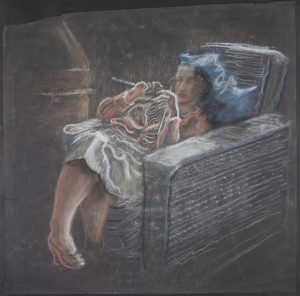In this blog post (part 2 of two blogs), SGSAH PhD intern, Molly McCracken shares her research about the Kinecraft Society.
Though the eventual graduation of members of the original Kinecraft Society led to its informal disbanding, these students variously continued their involvements in filmmaking, in a few cases becoming some of Scotland’s earliest filmmaking professionals. Perhaps the most famous member of the group was Norman McLaren, who was heavily involved in the production of ‘Seven Till Five’, ‘Camera Makes Whoopee’, and ‘Hell Unltd’. Following festival screenings of his productions, he was hired by Grierson and worked at the General Post Office (GPO) film unit – some of the films he made at this time, such as ‘Defence of Madrid’, continued to be screened at GSA via Biggar’s involvement with the Kino Film Group.

McLaren later moved to New York, where he began to experiment with animation, before moving to Canada where he worked for the Canadian National Film Board. Throughout his career McLaren was regarded as a highly influential and innovative filmmaker, winning an Oscar, BAFTAs, and other awards at the Cannes and Venice film festivals.
Another Kinecraft member, Stewart McAllister, received a travelling bursary from GSA; in correspondence to the School’s Secretary, he describes using this funding to visit film studios in Sweden and learning about their distinct “methods of scene construction”(GSAA/SEC/1). Materials held in the National Library of Scotland’s Moving Image Archive follow McAllister’s career as an editor: like McLaren he worked in the GPO Film Unit from 1937 and was later the editor of Humphrey Jennings’ wartime documentaries. After his death in 1962, his obituary was featured in prominent publications such as The Times. A biography of McAllister by Dai Vaughan, titled ‘Portrait of an Invisible Man’, reassesses his significant impact as a film editor, suggesting his own career and the job more broadly has largely been overshadowed in discussions of cinematic art.
Violet Anderson (later Violet Neish) likewise continued her filmmaking career beyond her years at GSA (1929-1933). One of the original Kinecraft members, she helped produce ‘Seven Till Five’ and ‘Camera Makes Whoopee’ during her studies, before working as an art teacher for several years after graduation. She later went on to produce Glasgow Junior Instruction Centre, a film about the teaching of arts and crafts at a charity for the unemployed.

She later produced ‘Heil Osterriech’, a film following the social and political transformations of Austria c1937: screened at SAFF 1938 (where celebrated director Alfred Hitchcock was adjudicator). Her film marks one of few surviving examples of a female-led production from the period.
William Maclean was a central figure of filmmaking at GSA, providing a key link between the School, its former students and filmmakers, and other film groups across Glasgow and Scotland. During his time as a teacher at GSA, Maclean was in turn a member of the Council of the Film Society of Glasgow; in essays written for them, he celebrates the romantic and imaginative potential of films, even in the documentary form. After leaving GSA he worked with various organisations such as Campbell Harper Films and Encyclopedia Britannica Films Inc to produce films in and about Scotland.
In a 1936 speech given at a meeting of the Royal Photographic Society, McLaren himself notes how the Kinecraft Society’s limited resources inspired a “greater ingenuity in the amateur”. Working with a strict budget of £10, worth roughly £580 today, it was, in McLaren’s view, the group’s financial hardship that inspired their creative approaches to production, techniques that would be developed in their respective careers as pioneers in filmmaking and animation.
Sources:
The Moving Image Archive, National Library of Scotland
Shepherd, Anna. Helen Unlimited, 2014.
